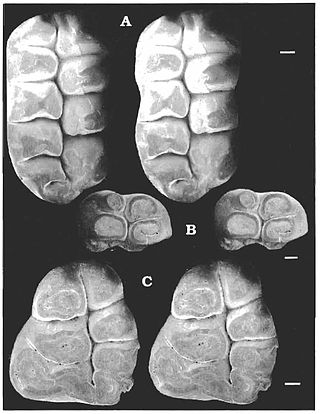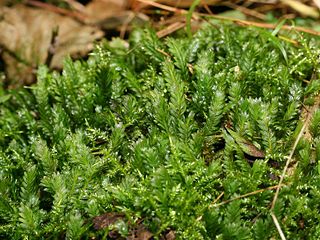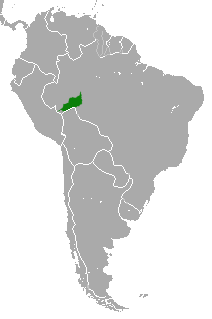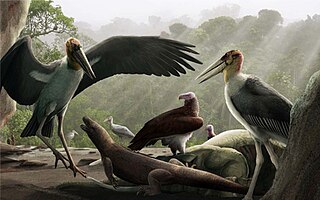
Catopsalis is a genus of extinct mammal from the Paleocene of North America. This animal was a relatively large member of the extinct order of Multituberculata. Most Multituberculates were much smaller.

The little ringed plover is a small plover. The genus name Charadrius is a Late Latin word for a yellowish bird mentioned in the fourth-century Vulgate. It derives from Ancient Greek kharadrios a bird found in river valleys. The specific dubius is Latin for doubtful, since Sonnerat, writing in 1776, thought this bird might be just a variant of common ringed plover.

Fissidens adianthoides, the maidenhair pocketmoss, is a moss in the family Fissidentaceae. It was first collected by Hedwig in 1801.

Hershkovitz's titi monkey is a species of titi monkey, a type of New World monkey, from South America. It is found in Bolivia, Brazil, and Peru. The common name is in reference to American zoologist Philip Hershkovitz, who described the species as Callicebus dubius in 1988.

Ditchling Beacon is the highest point in East Sussex, England, with an elevation of 248 m (814 ft). It is south of Ditchling and to the north-east of Brighton. It is a large chalk hill with a particularly steep northern face, covered with open grassland and sheep-grazing areas. It is the third-highest point on the South Downs, behind Butser Hill and Crown Tegleaze.

Fissidens is a genus of haplolepideous mosses (Dicranidae) in the family Fissidentaceae.

Isopogon dubius, commonly known as pincushion coneflower, is a species of plant in the family Proteaceae and is endemic to the south-west of Western Australia. It is a shrub with sharply-pointed, deeply lobed or pinnate leaves and more or less spherical heads of pink to reddish pink flowers.
Fissidens polypodioides is a species of moss first classified by Johannes Hedwig.

Leptoptilos robustus is an extinct species of large-bodied stork belonging to the genus Leptoptilos that lived on the island of Flores in Indonesia during the Pleistocene epoch. It stood at about 1.8 metres (5.9 ft) tall and weighed up to an estimated 16 kilograms (35 lb). The majority of the discoveries are concentrated in Liang Bua cave located slightly north of Ruteng in the East Nusa Tenggara province.

Microsteus is an extinct genus of small selenosteid arthrodire placoderms known from the Upper Frasnian Kellwasserkalk facies of Late Devonian Germany.

Anochetus dubius is an extinct species of ant in the subfamily Ponerinae known from two possibly Miocene fossils found on Hispaniola. A. dubius is one of eight species in the ant genus Anochetus to have been described from fossils found in Dominican amber and is one of a number of Anochetus species found in the Greater Antillies.
Astroblepus fissidens is a species of catfish of the family Astroblepidae. It can be found on Ecuador.

Bathyphantes is a genus of dwarf spiders that was first described by Anton Menge in 1866.

Pandanus dubius, commonly known as bakong or knob-fruited screwpine, is a species of Pandanus (screwpine) native to Island Southeast Asia, New Guinea, and the Western Pacific islands, and possibly also to the Andaman and Nicobar Islands.

Fissidens limbatus commonly known as Herzog's pocket-moss, is a moss in the family Fissidentaceae. This species is found growing in high elevations in tropical America in addition to the US, Mexico and Canada. Montagne first collected F. crispus in 1838.

Fissidens taxifolius is a species of moss in the Fissidentaceae family. It has a cosmopolitan distribution.














